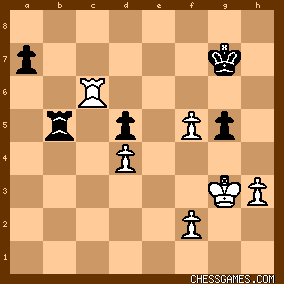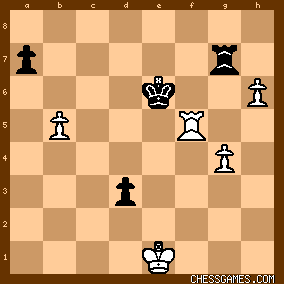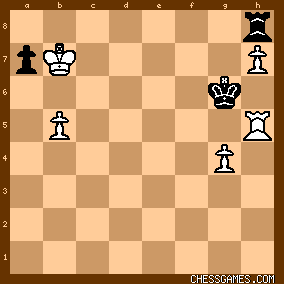|
< Earlier Kibitzing · PAGE 2 OF 2 ·
Later Kibitzing> |
| Jun-03-06 | | Dionyseus: <chancho> <Any salvation in 34...Kxh7?> After 34...Kxh7 white simply pushes kingside pawns to win. For example 35.axb5 Rd7 36.Rc5 exd4 37.exd4 f5 38.gxf5 Kg7 39.Rc6 Rb7 40.Rc5 Rd7 41.Rc6 Rb7 42.Kg2 Rxb5 43.Kg3

click for larger viewPlay might continue like 43...Rb1 44.f4 Rb3+ 45.Kg4 gxf4 46.Kxf4 Rxh3 47.Ra6 Rh8 48.Rxa7+ Kf6 49.Ra6+ Ke7 50.Ke5 Rd8 51.Re6+ Kf7 52.Rd6 Rb8 53.Rd7+ Kf8 54.Rxd5 to arrive in this position:

click for larger viewWhich is a tablebase win for white, mate in 29 moves actually. |
|
| Jun-03-06 | | euripides: After <34 Nxh7 Kxh7 35 axb5> White will be able to play Rc5 when he will be a pawn up with the better rook, and I imagine should win.
But <34 Nxh7> Rc6 looks interesting. Now 35 Rb1 loses a piece to Bd3 because 36 dxe5 would no longer attack the rook. Some possible lines are 35 Rxc6 Bxc6 36 Nxf6+ Kf7 37 Nh5 Bxa4 when White is a pawn up but BLack's outside passed pawn looks good, or 35 Rxc6 Bxc6 36 Nxf6+ Kf7 37 Nh7 Kg6 38 Nxg5!? (Nf8+ offers a repetition) Kxg5 39 a5 e4 when Black seems to restrain White's passed pawns, or even 35 Rxc6 Bxc6 36 Nxf6+ Kf7 37 Nh7 Kg6 38 Nxg5!? Kxg5 39 dxe5 !? Bxa4 which is wild. However, White's best line looks like 35 Rxc6 Bxc6 36 Nxf6+ Kf7 37 dxe5 Ke6 38 f4 (or perhaps Nh7 when Black cannot protect g5) gxf4 39 exf4 Bxa4 when I imagine White, two pawns up with four united passed pawns, probably wins, but Black's two passed pawns are still a bit tricky. There may also be other possibilities with 35 Nxf6+ first but I think they come to the same thing. All this is eyeballed from the screen so I may be missing something obvious. |
|
| Jun-03-06 | | Dionyseus: <pavkata> <umm, isn't 34. Nxh7 just met with Bd7 winning the knight..i don't have a computer so i don't know> After 34...Bd7 white simply plays 35.dxe5 and the white knight is saved because black must recapture with fxe5 otherwise it'd lose the rook. Play might continue 36.Nxg5 Bxa4 37.Ra1 Ra6 38.Nf3 e4 39.Nd4 to arrive at this position:

click for larger viewwhite simply pushes his kingside pawns to win. Play might continue like 39...Kg7 40.Ra3 Kg8 41.h4 Kf7 42.Kg2 Kg6 43.Kg3 Kg7 44.Kf4 Kg8 45.g5 Kf8 46.Ke5 Kg8 47.h5 Ra5 48.g6 Kh8 and white has a mate in 12 or less here:

click for larger viewFor example 49.Kf6 Ra6+ 50.Ne6 Rc6 51.Rxa4 a5 52.Rxa5 Rc8 53.Ra7 Re8 54.Ng5 Rf8+ 55.Nf7+ Kg8 56.h6 Rc8 57.h7+ Kf8 58.h8q# |
|
| Jun-03-06 | | Dionyseus: <euripides> <However, White's best line looks like 35 Rxc6 Bxc6 36 Nxf6+ Kf7 37 dxe5 Ke6 38 f4 (or perhaps Nh7 when Black cannot protect g5) gxf4 39 exf4 Bxa4 when I imagine White, two pawns up with four united passed pawns, probably wins, but Black's two passed pawns are still a bit tricky. > After 37...Ke6 in your line white simply plays a5. Play might continue like 38...Kxe5 39.Nh7 d4 40.Nxg5 Kf6 41.h4 and this is a simple win for white:

click for larger view |
|
| Jun-03-06 | | euripides: <dio> yes that looks convincing. Even the attempt to win a pawn back with 41...de 42 fe Bd7 runs into Ne4+ and Nf2, or 41...d3 42 Kf1. I guess triple pawn sacrifices in minor piece endgames are not such a good habit. |
|
Jun-04-06
 | | beatgiant: <Dioneseus>
From the following position in our analysis:

click for larger viewAfter 43...Kf6 44. Rg8, Black would probably play <44...Kf7>, then 45. Rg5 Kf6 is repetition so you must have been thinking of 45. Ra8 Rxg4 46. Rxa7+ Ke6 47. b6 Rb4 48. Rb7 Kd6, which looks drawish to me. What am I missing? |
|
| Jun-15-06 | | Dionyseus: <so you must have been thinking of 45. Ra8 Rxg4 46. Rxa7+ Ke6 47. b6 Rb4 48. Rb7 Kd6, which looks drawish to me. What am I missing?> Yes that ending does look drawish. How about 41.h4 instead of Ke2.

click for larger view
Play might continue like 41...d3 42.Ke1 Kf6 43.Rf5+ Kg6 44.h5+ Kh6 45.Rf6+ Kg5 46.Rg6+ Kf4 47.h6 and it looks like black's in big trouble here:

click for larger view
47...Rc7 48.g5 Kg4 49.Kd2 Kf5 50.Rg7 Rc8 51.Rxa7 and black's best move here is to resign. |
|
| Jun-15-06 | | Marvol: Kramnik should be glad to play games like this upon his return, despite nearly losing them. Although it's a nice confidence-booster to win, games like against Naiditsch and especially Aleksandrov are not exactly what he would like to get in preparation for his match against Topalov. The more hard work he gets to do the better he will be prepared. That hard work, get-your-hands-dirty type of game is likely to be more common against Topalov than the easy win. One day he may thank Kamsky for this game. |
|
| Jun-15-06 | | alicefujimori: <Marvol><games like against Naiditsch and especially Aleksandrov are not exactly what he would like to get in preparation for his match against Topalov>Well, there's still Dortmund to come. That will be the real test of Kramnik's form. |
|
Jun-21-06
 | | beatgiant: <Dioneseus>
I haven't had time to analyze this in full detail, and maybe you're right that White wins. But at least Black can put up a better fight.For example (after 34. Nxh7 exd4 35. axb5 dxe3 36. Nxg5 exf2+ 37. Kxf2 fxg5 38. Rc6 Rd7 39. Rg6+ Kf7 40. Rxg5 d4 41. h4 d3 42. Ke1 given by you), and now <42....Kf6>. After that, if 43. Kd2 Rd4 transposes to the line we studied before, so White tries 43. Rf5+ Ke6 44. Rf4 Ke5 45. Ra4 Rb7. Now one possibility is 46. Kd2 Rxb5 47. Kxd3 a5, and I think Black has drawing chances. This line is getting much too long, so I'll wait for others' comments before adding more detail ;-) |
|
| Jun-21-06 | | Dionyseus: <beatgiant> <so White tries 43. Rf5+ Ke6 44. Rf4> Why 44.Rf4? h5 seems much stronger to me. Play might continue 44.h5 d2+ 45.Kd1 Rd4 46.Rg5 Kf6 47.Rg6+ here:

click for larger viewKe5 would be disastrous after 48.h6, so Kf7 is necessary. Play might continue 48.Ra6 Rd7 49.g5 Kg8 50.g6 Kg7 51.Ra2 Rb7 52.Rxd2 Kh6 to arrive at this position:

click for larger viewand white continues 53.Rd5 Re7 54.Rf5 Re8 55.Rf7 Rd8+ 56.Ke2 Re8+ 57.Kf3 Rd8 58.g7 Rg8 59.Kf4 and black is dead here:

click for larger view |
|
Jun-23-06
 | | beatgiant: <Dionyseus>
As I said, I haven't time for very detailed analysis, but on your suggested 44. h5 (in the line we've been discussing above), Black can try 44...Rg7 and at first glance, White has no better than 45. Rf4 anyway, with problems similar to the line I posted earlier such as 44. h5 Rg7 45. Rf4 Ke5 46. Ra4 Kf6, etc. |
|
| Jun-24-06 | | Dionyseus: <beatgiant> after 44...Rg7 white simply plays 45.h6 and black is in big trouble here:

click for larger viewfor example, if 45...Rxg4 then white wins easily with 46.Rh5 Rg8 47.h7 Rh8 and now all white has to do is bring king to a6 and there's nothing black can do about it:

click for larger viewIf 45...Rh6 then white simply wins with 46.Rh5 Kf6 47.Kd2 Kg6 48.Kxd3 Rd7+ 49.Kc4 Rc7+ 50.Kb4 Rh7 51.Kc5 and black has no hope of surviving, cannot stop the g and h pawns and defend the a pawn at the same time:

click for larger viewKf6 52.Kc6 Kg6 53.Rd5 Rh8 54.h7 Kf6 55.Rh5 Kg6 56.Kb7 and this is completely lost for black:

click for larger view |
|
Jun-28-06
 | | beatgiant: <Dionyseus>
Yes, your latest line is a win. But since this line is over 10 moves deep and leads to situations in which small changes make a difference between a win and a draw, it is certainly very tempting (but very time-consuming) to go on analyzing this. In the ensuing rook ending, Black would be trying to trade his d-pawn for White's b-pawn, while White's trying to advance the kingside decisively before Black can accomplish that. I did see a few more potential improvements, but I'll have to come back to it later when I have more time. Thanks for all the lessons ;-) |
|
| Jun-28-06 | | delterp: I haven't looked closely, but would not 26 ♗d7 win either the e6 pawn or the exchange? |
|
| Jun-28-06 | | mang00neg: if 26 Bd7, ...Rxc5 gets 2 pieces for the rook |
|
| Jun-28-06 | | RookFile: Folks - any time you've got a rook and two pawns on the kingside (as in some of these diagrams) - if the defender does not have pawns to obstruct them, then this is an irresitable force. Try it - Put white pawns on g4 and h5, and a white rook on g6. With White to move, you can put the black king and rook anywhere on the board you want to, and they cannot prevent this irresistable force from ramming home a queen. I believe it was Smyslov and Levenfish who pointed this out in their book on rook endings. |
|
Jun-28-06
 | | beatgiant: <RookFile>
<Folks - any time you've got a rook and two pawns on the kingside (as in some of these diagrams) - if the defender does not have pawns to obstruct them, then this is an irresitable force.>Right, but if the other side also has a passed pawn then it may become a race. That's the whole point of the analysis we've been working on above. |
|
| Jun-28-06 | | RookFile: For example, once you know this, you can just look at beatgiant's and Dionyseus's diagrams from June 4 - 15, the ones where white has a rook and two kingside pawns, and evaluate them as "white wins". Once the white king blockades the black passed pawn, black can safely resign. |
|
| Jun-28-06 | | RookFile: I think Dionyseus is more or less trying to explain this to you. For example, the June 15 diagram, where
dionysues says:
<Yes that ending does look drawish. How about 41.h4 instead of Ke2. > I guarantee you, any GM would simply resign the game, as black, after 41. h4. |
|
| Jun-28-06 | | RookFile: So, anyway, I highly recommend Levenfish's and Smyslov's book, it will cause you to look at rook and pawn endings in a whole new light. Here's another example:
Imagine the following 'game'. White has a king and a pawn, and black has only a rook. (No king). For the moment, let's put the pawn on g4, and the king on f4, and the black rook on g8. White 'wins' the game if he can safely advance the pawn, and black 'wins' if he prevents the pawn from advancing. Smyslov and Levenfish then go on to explain how you can tell at a glance who will win. The rule is: there need to be 3 vacant ranks between the rook and the pawn. So, in the example given above, black can successfuly play 1... Rf8+ 2. Kg3 Rg8 2. Kf4 Rf8+ 3. Kg5 Rg8+ 4. Kf5 Rf8+ 5. Kg6 Rg8+, forcing white to retreat, and preventing the pawn from advancing. However, move everything up a rank, and black 'loses'. (King on f5, pawn on g5, rook on g8) 1.... Rf8+ 2. Kg6 Rg8+ 3. Kf6 Rf8+ 3. Kg7, and white wins, because he will be able to play 4. g6. The Levenfish and Smyslov book is full of insights like this, that can help more quickly evaluate rook and pawn endings. |
|
| Aug-13-06 | | Snaeulf: excuse me, but 51 Rf5 Rh6+ 52 Rf6 Rxf6 53Kxf6 is winning for white and 51 ... Ra1 or others rook moves let white push his pawn. Black should lose here.
Plz tell me if i miss a drawing move :) |
|
| Aug-20-06 | | MagnaPsygnosis: mmmm
This is a very interresting match |
|
| Feb-16-09 | | WhiteRook48: was the ending already a draw? |
|
| Feb-16-09 | | Abaduba: <Snaeulf> Black draws against 51. Rf5 not with …Ra6+ but with 51. …Ra7! in order to drive back the White King with …Rg7+.
If 52. g4, then 52. …Rg7+ 53. Kh4 Rh7+ 54. Kg5 Ra7!, preparing to cut off the White King along the 3rd rank as in Philidor's Draw. If White prevents this with 55. Rf6, then Black plays Kg7 and White cannot make progress. If instead 52. Rf3, then 52. … Rg7+ 53. Kf4
(53. Kh5 Rh7+ 54. Kg5 Rg7+ 55. Kh4 Rh7+ 56. Kg3 is obviously not making progress, e.g. 56. …Rf7 intending …Kg7, while trading rooks is a drawn K+P endgame.)
53. …Rf7+ where 54. Rxf7 Kxf7 is a drawn K+P ending because Black has the opposition, while 54. g5 Kg7! 55. Rxf7+ (otherwise 55. …Rxf6 56. gxf6+ Kf7 =) is still drawn.
Any King move is simply met with a series of checks, where the White King must either return to f5 or else be cut off from his pawn. Against a different Rook move on move 51, …Ra6+ is sufficient to draw, as you mentioned. |
|
 |
|
< Earlier Kibitzing · PAGE 2 OF 2 ·
Later Kibitzing> |





































